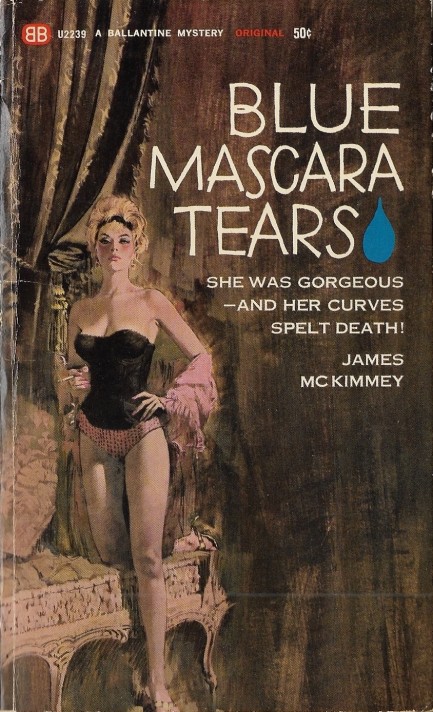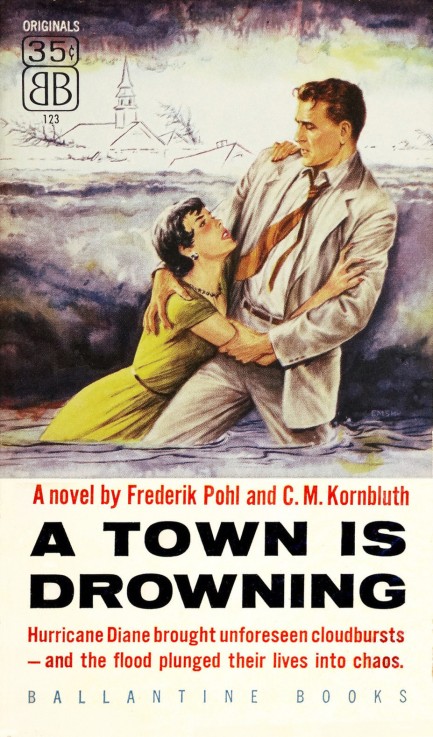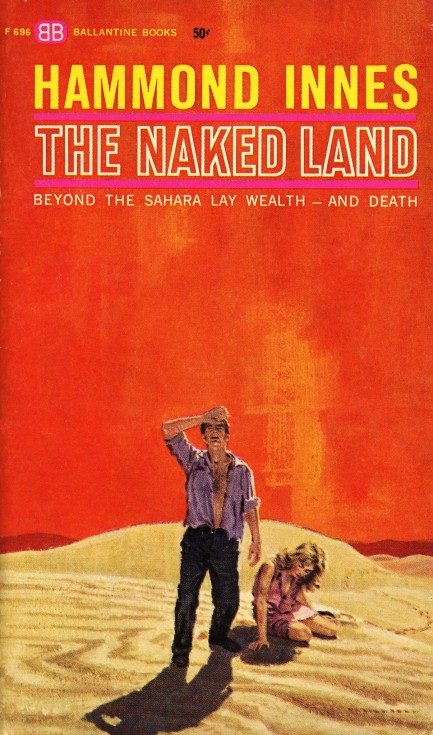 A case of the permanent blues. 
The lyrically titled Blue Mascara Tears is a dark one from James McKimmey, author of able efforts such as The Long Ride and Cornered. In the tale a San Francisco cop named Jack Cummings can't nail crime kingpin Knocko Cutter because the fix is in at the police department. Cutter also employs two vicious and efficient torturer-killers to silence witnesses, which works for a while, but as Cummings notes, “The collapse was coming from the fault in the structure itself.” In other words, the kingpin's sociopathic nature compels him to mistreat his most trusted henchmen, and even henchmen have a breaking point.
Two events are threaded through the plot: the robbery and murder of a man who had $65,000 in his possession; and the rape of a fourteen-year-old girl. The crimes quickly tie together, reveal twists and lies, and the kingpin's search for the missing cash presents the most meager of openings for Cummings to possibly nail him. But that's easier said than done when the police department is corrupt from top the bottom. Realizing the odds are long, Cummings grows more determined—and more willing to cross the line. It all leads to a climax that's expertly dragged out to the final paragraph.
And speaking of experts, the front on this 1965 Ballantine paperback was painted by Ron Lesser, one of the more accomplished illustrators of the mid-century period. Occasionally everything dovetails perfectly with cover design. Here you have excellent art from Lesser, a unique choice for a font, and a perfect blue teardrop, which we assume was an inspiration from Ballantine's art director. Add them together with McKimmey's story and Blue Mascara Tears is a through-and-through success.
 You can make it, honey. Just imagine the future satisfaction you'll get blaming me for coming here in the first place. 
This is a dramatic piece painted by Ed Emshwiller for Frederik Pohl and C.M. Kornbluth's 1955 novel A Town Is Drowning. Did Emshwiller run out of paint, or is the fact that the town in the background is a mere ink drawing symbolic of its fragility and impermanence? We're pretty sure it's option two, and the result is a very striking cover, with some nice color bleeds as one of its main features. The story is exactly as the title suggests, with fictional Hebertown, located somewhere in the American northeast, being hit by precipitation from a hurricane that sends the local river well over its banks to destroy large portions of the town. The rains and flooding are over by the halfway mark, at which point Pohl and Kornbluth focus on various aspects of social collapse, from infrastructure breakdown to looting.
Disaster-triggered social regression has been written many, many times. Some of the best efforts along those lines kill the soul to even read. A Town Is Drowning is a decent pop fiction undertaking on a non-apocalyptic but still somewhat harrowing scale. It isn't bad, but we think it's a little too impersonal. We'll concede that the authors' ambitions were to have a large array of people to show many different perspectives, but that makes getting to know them—hence caring about them—difficult. At least two characters could have been ditched to allow others to come to the fore. But what do we know? Pohl and Kornbluth collaborated half a dozen times, so they clearly loved the result. They would go on to much acclaim, with Pohl peaking with the Hugo and Nebula Award winner Gateway, and its sequel Beyond the Blue Event Horizon. A Town Is Drowning is not on that level but it's interesting to catch Pohl here early in his career.
 Are you absolutely sure the place we're staying is this way? 
Smartphones have certainly made this situation less likely to occur, but on the other hand, when you come back from a trip which story do you tell your friends? The one about how you got exactly where you wanted to go, or the one about how you got lost and thought you were done for? Hammond Innes sets The Naked Land in French Morocco, as it was called then, and we can really sympathize with the two figures on the cover art because, as some of you may remember, we've been lost in Morocco too. One of the main characters here is a missionary—and we know that always goes well—who heads down to the Magreb and ends up trying to secure a mineral rich patch of land. You know the drill. Westerners trying to claim their divinely appointed riches while benighted locals stand in the way. You also get the added elements of assumed identity, spywork, communism, a murder mystery, Marrakech's mazelike central souk (awesome, by the way), and finally, an actual element—silver. The book was originally published in Britain as The Strange Land, with this U.S. edition coming in 1954 fronted by cover art from Ed Valigursky.
|
 |

The headlines that mattered yesteryear.
1939—Batman Debuts
In Detective Comics #27, DC Comics publishes its second major superhero, Batman, who becomes one of the most popular comic book characters of all time, and then a popular camp television series starring Adam West, and lastly a multi-million dollar movie franchise starring Michael Keaton, then George Clooney, and finally Christian Bale. 1953—Crick and Watson Publish DNA Results
British scientists James D Watson and Francis Crick publish an article detailing their discovery of the existence and structure of deoxyribonucleic acid, or DNA, in Nature magazine. Their findings answer one of the oldest and most fundamental questions of biology, that of how living things reproduce themselves. 1967—First Space Program Casualty Occurs
Soviet cosmonaut Vladimir Komarov dies in Soyuz 1 when, during re-entry into Earth's atmosphere after more than ten successful orbits, the capsule's main parachute fails to deploy properly, and the backup chute becomes entangled in the first. The capsule's descent is slowed, but it still hits the ground at about 90 mph, at which point it bursts into flames. Komarov is the first human to die during a space mission. 1986—Otto Preminger Dies
Austro–Hungarian film director Otto Preminger, who directed such eternal classics as Laura, Anatomy of a Murder, Carmen Jones, The Man with the Golden Arm, and Stalag 17, and for his efforts earned a star on Hollywood's Walk of Fame, dies in New York City, aged 80, from cancer and Alzheimer's disease. 1998—James Earl Ray Dies
The convicted assassin of American civil rights leader Martin Luther King, Jr., petty criminal James Earl Ray, dies in prison of hepatitis aged 70, protesting his innocence as he had for decades. Members of the King family who supported Ray's fight to clear his name believed the U.S. Government had been involved in Dr. King's killing, but with Ray's death such questions became moot.
|

|
|

It's easy. We have an uploader that makes it a snap. Use it to submit your art, text, header, and subhead. Your post can be funny, serious, or anything in between, as long as it's vintage pulp. You'll get a byline and experience the fleeting pride of free authorship. We'll edit your post for typos, but the rest is up to you. Click here to give us your best shot.

|
|










































































